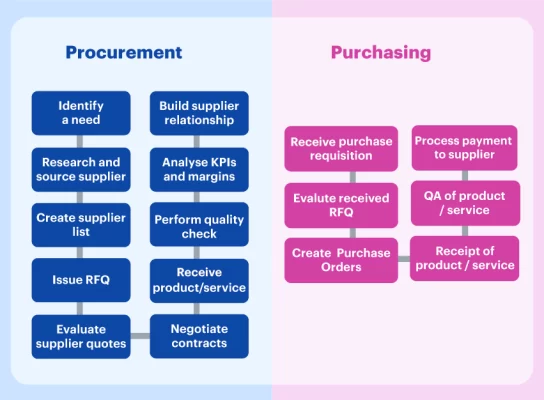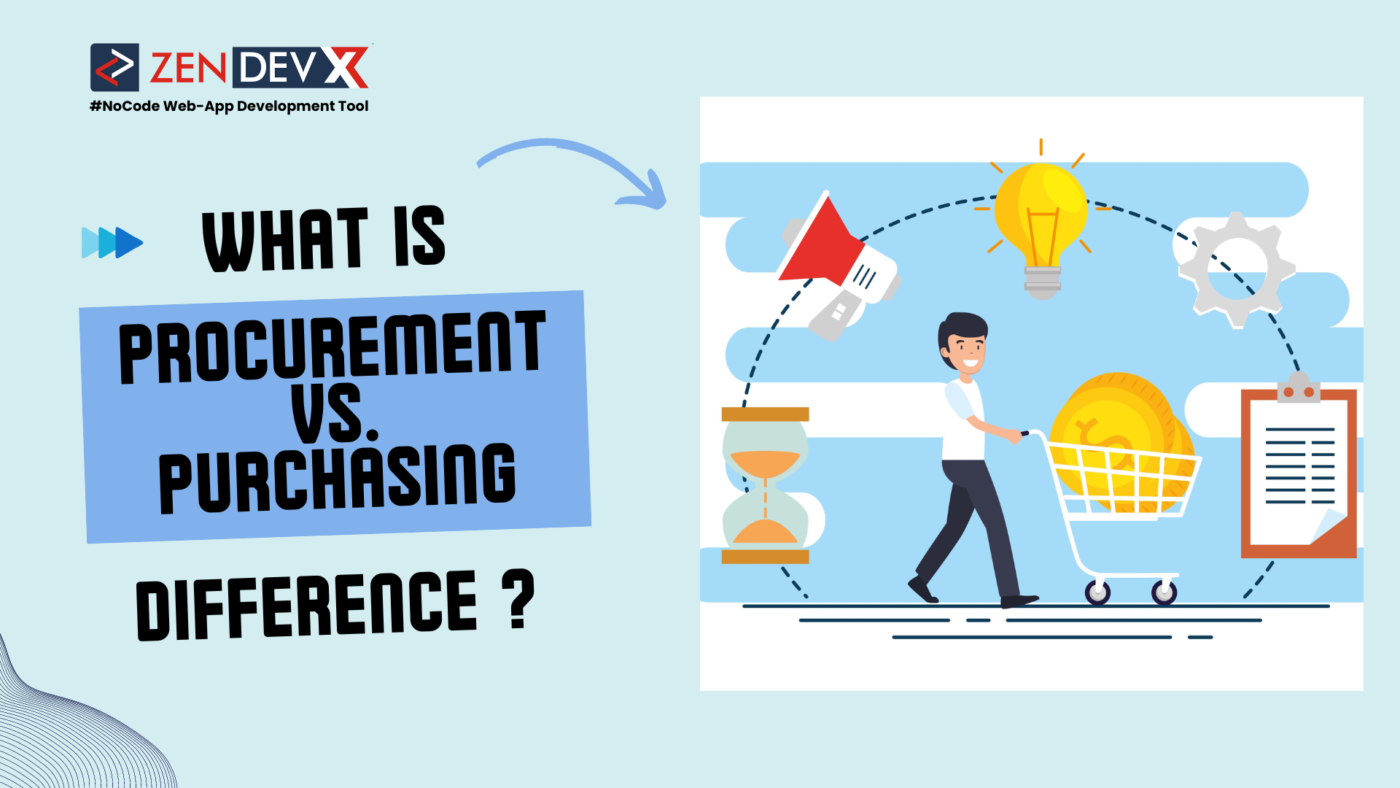Those two functions are actually quite distinct—in their intent, the tasks they cover, the people involved, and, most notably, what they accomplish.
If you ask a layman about the difference, you may get a reply that purchasing and procurement are one and the same. But, if you ask the same question to a procurement officer of an enterprise, you’ll get a significantly longer answer as to how and why there’s a world of differences between procurement and purchasing.
It is true that a few organizations prefer to use one term over the other, but failing to learn the key differences between purchasing and procurement can make an organization overlook key components that have the potential to break an organization’s bottom line.
Now, let’s dive deeper into the concept of procurement vs purchasing, and see how they differ from each other.
What is procurement?
Procurement encompasses the entire end-to-end process of acquiring goods, services, or works from external sources. It includes identifying needs, sourcing, negotiating, purchasing, receiving and inspecting goods, invoicing, payment, and managing suppliers–while saving cost, reducing time, and building win-win supplier relationships.
An end-to-end procurement process consists of the steps listed below:
- Surveying the market
- Spotting potential suppliers
- Creating an approved list of vendors
- Spotting internal needs
- Creating a purchase order online
- Requesting proposals and evaluating quotations
- Selecting the right supplier and negotiating effectively
- Receiving goods and performing quality checks
- Developing and managing contracts
- Obtaining invoice approvals and fulfilling payment terms
- Establishing a good supplier relationship
What is purchasing?
Purchasing is the set of functions associated with acquiring the goods and services that an organization requires. Purchasing is a small subset of the broader procurement function. This process includes activities like ordering, expediting, receiving, and fulfilling payment.
Listed below are the steps in the purchasing process:
- Obtaining a purchase requisition
- Requesting proposals and evaluating quotations
- Dispatching official purchase orders
- Receiving products and services
- Checking the quality of delivered items
- Effecting payment to vendors
Key Differences Between Procurement and Purchasing

Procurement and purchasing are two processes that are done during the process of acquiring goods and services for an organization. However, they vastly differ in their method and approach. This table represents the key differences between procurement and purchasing:
| Procurement | Purchasing |
|---|---|
| Activities related to acquiring goods and services | Functions associated with buying goods and services |
| Steps that happen before, during, and after purchase | The straightforward process of purchasing commodities |
| Used in a production environment (internal process) | Used in a wholesale environment (external process) |
| Puts more importance on an item’s value than its cost | Tends to focus more on the item’s price than its value |
| Refers to a set of tasks that spot and fulfill needs | Refers to the specific task of committing expenditure |
| Includes need recognition, sourcing, and contract closure | Includes ordering, expediting, and payment fulfillment |
| Follows a proactive approach to spot and fulfill needs | Follows a reactive approach to satisfy internal needs |
| Relational–focuses on creating long-term vendor relationships | Transactional–focuses on transactions than vendor relationships |
In addition to the list of differences mentioned above, procurement vs. purchasing includes another major difference. Purchasing focuses on short-term goals such as fulfilling the five rights in a transaction (right quality, right quantity, right cost, right time, and right place), whereas procurement focuses on strategic, long-term goals like gaining a competitive advantage or aligning itself with corporate strategy or goals.
The impact of an e-procurement solution
Whether you look at it as purchasing or procurement, there are a number of stakeholders involved–from internal parties like employees in different departments to external people like vendors and contract negotiators. Irrespective of the differences mentioned in the procurement vs. purchasing table, both processes demand meticulous documentation. They both comprise a complex web of procedures.
A single purchasing cycle might last for weeks, whereas a whole procurement cycle can last for months or even be repeated if a suitable bid is not found. If performed manually, both activities will have a common detriment of efficiency. Just the process of revising every document, evaluating every bid, and reviewing every invoice will cause too much delay. A comprehensive digital procure-to-pay solution, on the other hand, allows organizations to store all purchasing and procurement-related files in one centralized database.
While a shared network drive can fulfill this purpose, cloud-based procurement software can automate tasks and offer a level of convenience and efficiency that a manual system simply can’t match.
Recommended Reading:
- Business Process Reengineering: The Modern Way to Boost Efficiency and Profits [Guide of 2024]
- What is Rapid Application Development (RAD)? An Ultimate Guide for 2024
Procurement or purchasing, who is the winner?
In the battle between procurement vs. purchasing, there is no clear winner. Companies should pick an approach based on their unique needs. Small businesses may choose to purchase with an intention of keeping the process clean and simple, whereas enterprises may prefer a full-fledged procurement process just to make it a core part of their corporate strategy.
Whatever approach you choose to follow, manual tools like paper forms, spreadsheets, and word documents will end up doing more harm than good. Cloud-based procurement software improves productivity by standardizing strictly regulated processes like procurement and purchasing.
Thinking of revamping your purchasing or procurement process? Take a look at the list of benefits an ideal procurement software can offer your procurement team and help you create painless procurement processes from start to finish–PR to invoicing and payment.


